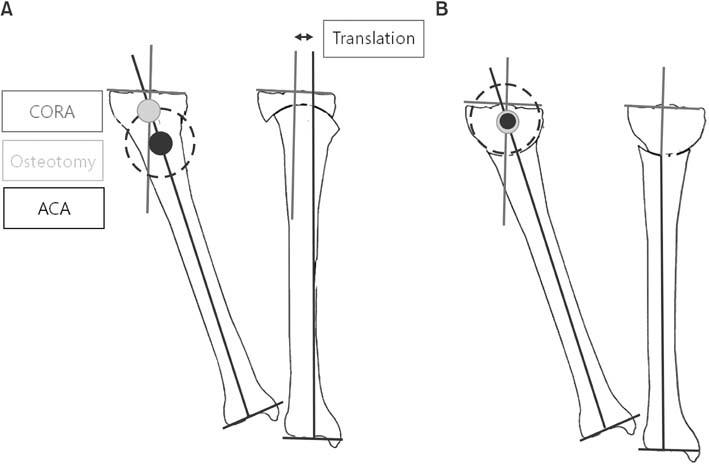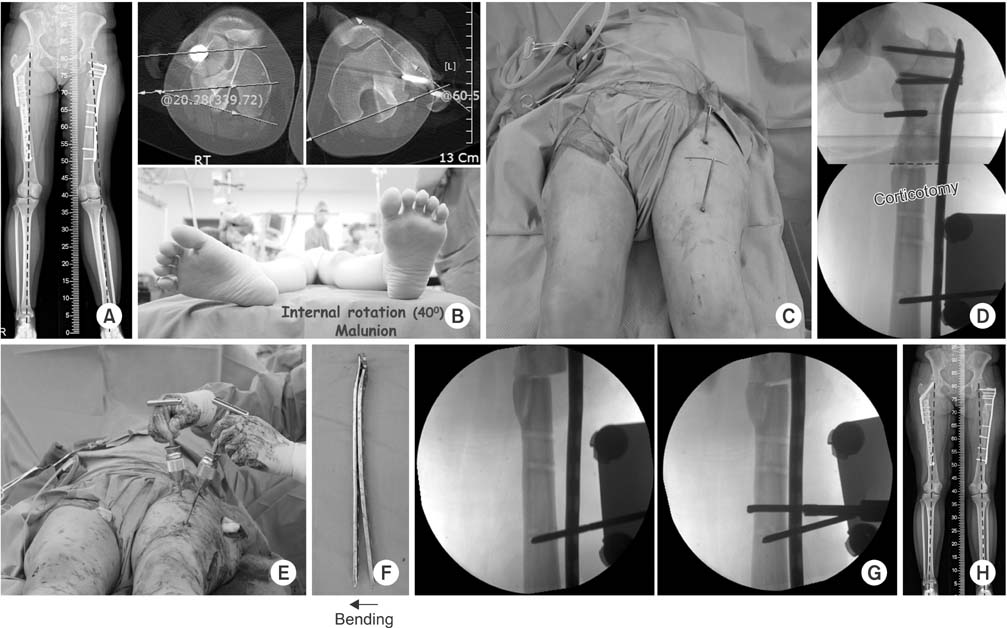J Korean Fract Soc.
2017 Jul;30(3):167-172. 10.12671/jkfs.2017.30.3.167.
Osteotomy Selection: Advantages, Disadvantages, and Indication
- Affiliations
-
- 1Department of Orthopedic Surgery, Guri Hospital, Hanyang University College of Medicine, Guri, Korea. kcpark@hanyang.ac.kr
- KMID: 2424127
- DOI: http://doi.org/10.12671/jkfs.2017.30.3.167
Abstract
- Malunion causes not only cosmetic problems, but also degenerative osteoarthritis due to changes in the anatomical and mechanical axes. Corrective osteotomy may be required in some cases to prevent these complications. The corrective osteotomy is divided into two types: Straight and dome. The straight type is divided into open and closed wedge, in accordance with the correction method. Surgeons should understand the indication, surgical procedure, as well as the advantages and disadvantages of each osteotomy method. Deciding on the method of corrective osteotomy depends on the degree of angulation, soft tissue condition, approximate with joint, implant type, and the experience of the surgeon.
Figure
Reference
-
1. Weber D, Weber M. Corrective osteotomies for malunited malleolar fractures. Foot Ankle Clin. 2016; 21:37–48.
Article2. Sanders R, Anglen JO, Mark JB. Oblique osteotomy for the correction of tibial malunion. J Bone Joint Surg Am. 1995; 77:240–246.
Article3. Bråten M, Terjesen T, Rossvoll I. Torsional deformity after intramedullary nailing of femoral shaft fractures. Measurement of anteversion angles in 110 patients. J Bone Joint Surg Br. 1993; 75:799–803.4. Dunlap K, Shands AR Jr, Hollister LC Jr, Gaul JS Jr, Streit HA. A new method for determination of torsion of the femur. J Bone Joint Surg Am. 1953; 35:289–311.
Article5. Murphy SB, Simon SR, Kijewski PK, Wilkinson RH, Griscom NT. Femoral anteversion. J Bone Joint Surg Am. 1987; 69:1169–1176.
Article6. Johnson KD, Johnston DW, Parker B. Comminuted femoral-shaft fractures: treatment by roller traction, cerclage wires and an intramedullary nail, or an interlocking intramedullary nail. J Bone Joint Surg Am. 1984; 66:1222–1235.7. Mize RD, Bucholz RW, Grogan DP. Surgical treatment of displaced, comminuted fractures of the distal end of the femur. J Bone Joint Surg Am. 1982; 64:871–879.
Article8. Wright JG, Treble N, Feinstein AR. Measurement of lower limb alignment using long radiographs. J Bone Joint Surg Br. 1991; 73:721–723.
Article9. Hollister AM, Jatana S, Singh AK, Sullivan WW, Lupichuk AG. The axes of rotation of the knee. Clin Orthop Relat Res. 1993; (290):259–268.
Article10. Paley D, Tetsworth K. Mechanical axis deviation of the lower limbs. Preoperative planning of uniapical angular deformities of the tibia or femur. Clin Orthop Relat Res. 1992; (280):48–64.11. Psley D. Principles of deformity correction. New York: Spring;2002. p. 102–108.12. Paley D, Herzenberg JE, Tetsworth K, McKie J, Bhave A. Deformity planning for frontal and sagittal plane corrective osteotomies. Orthop Clin North Am. 1994; 25:425–465.
Article13. Krackow KA, Pepe CL, Galloway EJ. A mathematical analysis of the effect of flexion and rotation on apparent varus/valgus alignment at the knee. Orthopedics. 1990; 13:861–868.
Article14. Paccola CA. A simplified way of determining the direction of a single-cut osteotomy to correct combined rotational and angular deformities of long bones. Rev Bras Ortop. 2011; 46:329–334.
Article15. Johnson EE. Multiplane correctional osteotomy of the tibia for diaphyseal malunion. Clin Orthop Relat Res. 1987; (215):223–232.
Article16. Sangeorzan BJ, Sangeorzan BP, Hansen ST Jr, Judd RP. Mathematically directed single-cut osteotomy for correction of tibial malunion. J Orthop Trauma. 1989; 3:267–275.
Article17. Russell GV, Graves ML, Archdeacon MT, Barei DP, Brien GA Jr, Porter SE. The clamshell osteotomy: a new technique to correct complex diaphyseal malunions. J Bone Joint Surg Am. 2009; 91:314–324.
Article
- Full Text Links
- Actions
-
Cited
- CITED
-
- Close
- Share
- Similar articles
-
- Osteotomy around the Knee: Indication and Preoperative Planning
- High Tibial Osteotomy
- Graft Selection and Fixation in Anterior Cruciate Ligament Reconstruction
- Comparison of the Advantages, Disadvantages, Clinical, and Radiological Results of Open Wedge and Closed Wedge High Tibial Osteotomy
- Lateral Closing Wedge Osteotomy of Tibia for Degenerative Arthritis






